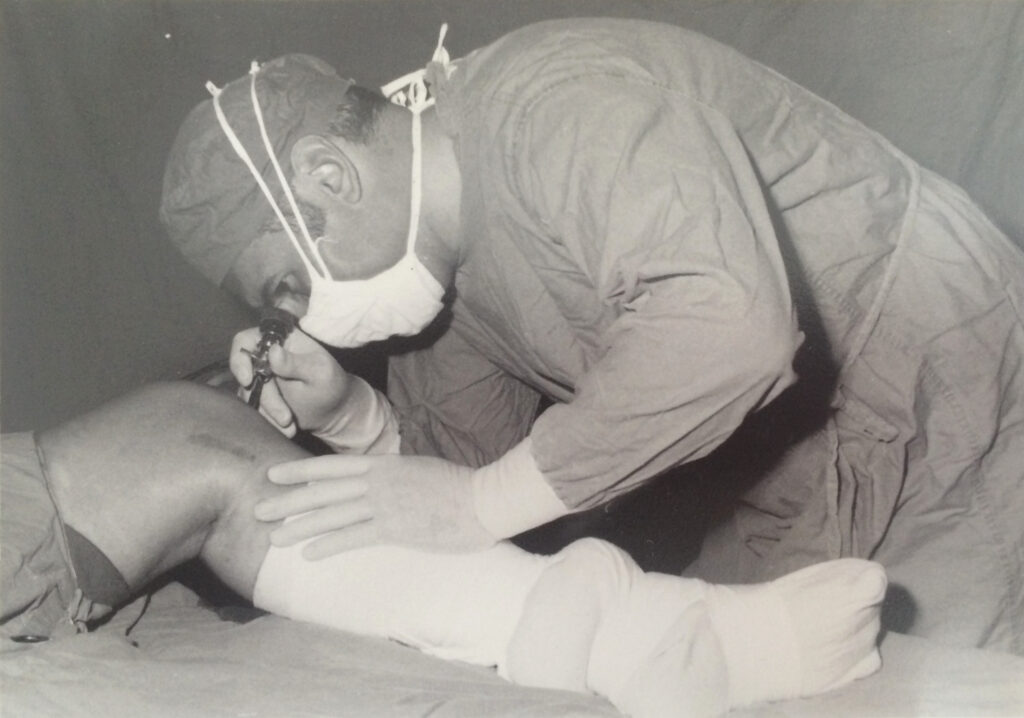The Dr. Robert W. Jackson Arthroscopy Collection was gathered by Toronto-born orthopedic surgeon Dr. Robert W. Jackson (1932-2010) over the course of his career. The collection includes many artifacts associated with the emergence and development of arthroscopic surgery beginning in the 1960s. In 2020, the collection was donated by Dr. Jackson’s family to the University of Toronto. His papers were accessioned by Library and Archives Canada (LAC).
The arthroscope is an optical instrument that, in combination with other apparatus and surgical tools, permits a surgeon to perform minimally invasive surgery on joints using small incisions. Its introduction improved the accuracy of diagnoses, while significantly shortening recovery times, most notably for knee surgery, which had previously required a much more invasive surgery to open the knee. Due to the frequency of knee injury in sport, arthroscopy is closely associated with sports medicine.

Dr. Robert W. Jackson’s collection documents the evolution of the arthroscope and related technology over several decades. He was notably involved in the development of several instruments. Sadly, he passed away without leaving a detailed account of its contents. It is hoped that his surviving students and colleagues will assist in the process of documenting these artifacts and their significance in order to develop a valuable material archive of one of orthopedic surgery’s most important 20th century developments.
The Dr. Robert W. Jackson Arthroscope Collection includes:
– An array of arthroscopes representing the evolution of that technology. It notably includes several examples of the “Type No. 21″, the first production arthroscope that was essential to founding the discipline.
– A large variety of arthroscopic forceps and other surgical tools.
– Two experimental electrogoniometers (Instrumented Spatial Linkage Devices ISLD) . These are research instruments intended to diagnose injury to the ACL by measuring the motion of the gait using servos.
– Several examples of rotary cutters as well as numerous consumable pre-sterilized cutting tips.
– Several examples of artificial joints and other implants.
Arthroscopic Technology:
The technology of arthroscopy is built on several basic components, though in many instances these have been elaborated and combined in various ways. The arthroscope itself is an optical instrument featuring a narrow shaft that can be inserted through an incision in a joint (a “portal”). It provides a means of inspecting the joint’s interior as well as guiding the operation of surgical tools, also inserted into portals.
Originally, observation was conducted through a viewfinder on the instrument. By the early 1990s, camera systems that relayed the image from the arthroscope to a screen in the operating room were considered well developed. The introduction of rod lenses, which began in the 1960s, greatly improved the instrument’s optical clarity and usability. A lighting system is required to illuminate the interior of the joint. The first production arthroscopes used a small, fragile halogen bulb, installed at the instrument’s tip, that gave off heat. Later, fiber optic lighting was introduced to separate the light source from the location of the surgery.
Arthroscopy involves an array of adapted surgical tools used to perform such operations as grasping, cutting, and gathering biopsy samples. Tubes, known as cannula, are used as a means to insert the arthroscope and other surgical tools. Arthroscopy usually features an irrigation system, typically fitted to a sheath around the arthroscope, that is used to distend the joint with saline solution.
In the 1980s, motorized rotary tools began to replace cutting forceps and drills in some applications. Around this time, pre-sterilized single-use consumables emerged, a sign of the technology’s wide adoption. This reduced the labour involved in sterilizing and maintaining arthroscopic equipment.
Historical Background:
Like most technologies, the arthroscope was not developed at a single moment. Rather, the tools and techniques were repeatedly investigated and improved at various locations over several decades, eventually reaching a state of maturity at which arthroscopy could be effectively used by surgeons. It reached this point in Japan in the decades following the Second World War. The traditional importance of kneeling and bowing within Japanese etiquette is said to have motivated the effort to diagnose and treat arthritic knees.
The first arthroscopic surgery was performed by Dr. Kenji Takagi of Tokyo in 1918 using a commercial cytoscope. Over the subsequent decades, Takagi and his students produced a series of improved arthroscopes, culminating in the “Type No. 21”, manufactured by Shinko Optical Co. of Tokyo Japan beginning in 1959. Developed by Dr. Masaki Watanabe (1921-1994), this was the first production arthroscope.
Jackson’s role concerns the adoption of this instrument by the wider orthopedic community, as well as the technology’s subsequent development. Watanabe’s initial efforts to present his arthroscopic technique had not been met with enthusiasm from his colleagues. Jackson, then a young sports physician, traveled to Tokyo on a research trip while on the staff of Canada’s winter athletes for the 1964 winter Olympics. On the advice of Toronto-based orthopedic surgeon Dr. Ian MacNab (d. 1992), Jackson sought out Dr. Watanabe at the Tokyo Teishin Hospital. There he learned Watanabe’s arthroscopic technique.
Jackson returned to Toronto with a Watanabe arthroscope and camera. In 1966, he and another of Watanabe’s students, Isao Abe, received a research fellowship that permitted them to perform 70 arthroscopic operations and to publish their results. At that time, only a handful of surgeons were using the arthroscope. Two conference presentations by Jackson in 1967, presenting the results of these investigations, played an important role in raising awareness about the efficacy of the technology.
The subsequent years witnessed a process of dissemination and diffusion through the professional bodies and teaching institutions of the orthopedic profession as evidence mounted about arthroscopy’s diagnostic advantages and improved healing times. A growing cohort of surgeons adopted the technology and published the results of their research. Training sessions were offered first at orthopedic conferences then at medical schools. Established instrument manufacturers, specializing in orthopedic surgery and endoscopy, began to develop and improve their own commercial arthroscopes. With technological improvements, including the development of novel surgical tools, arthroscopy evolved from a primarily diagnostic process towards an increasing array of well tested operative procedures.
